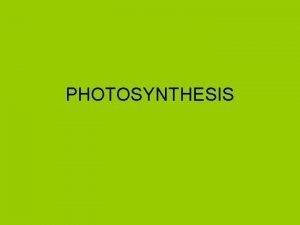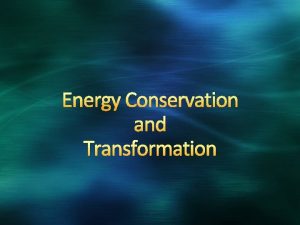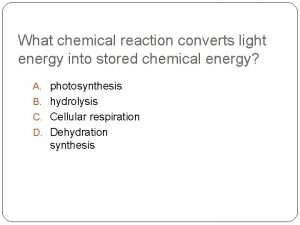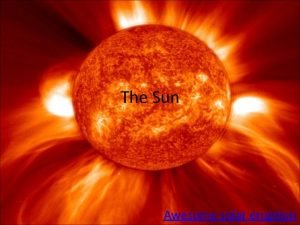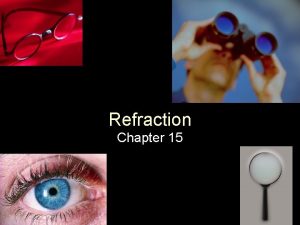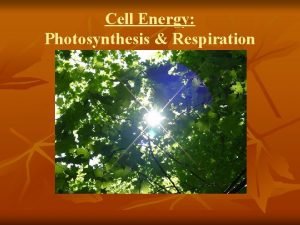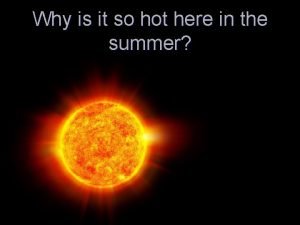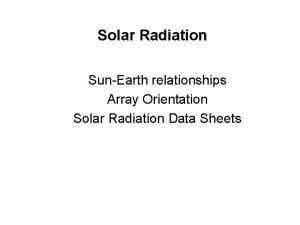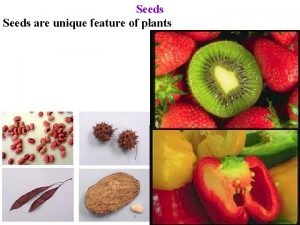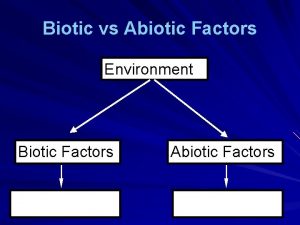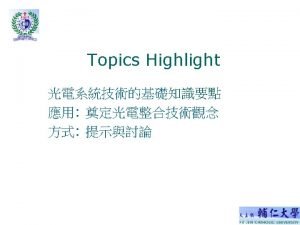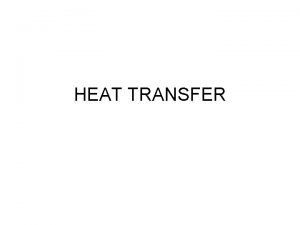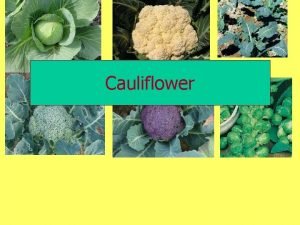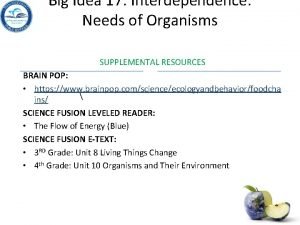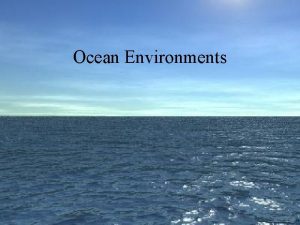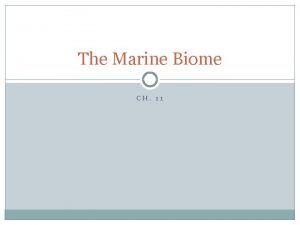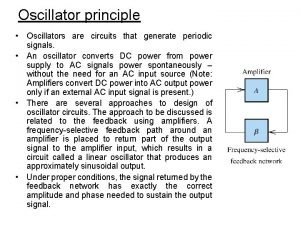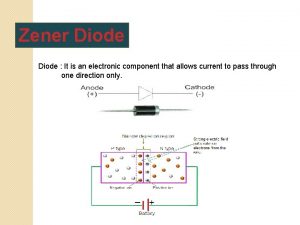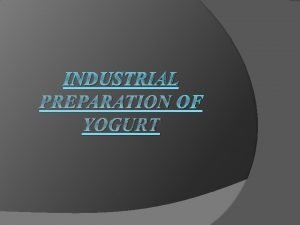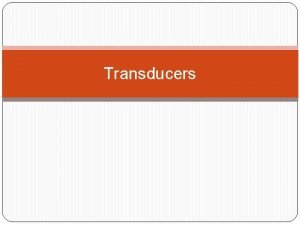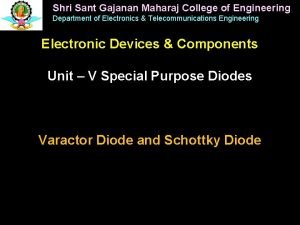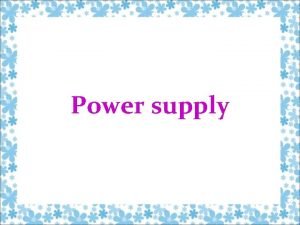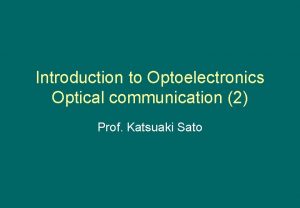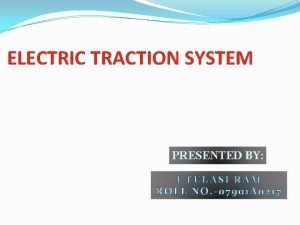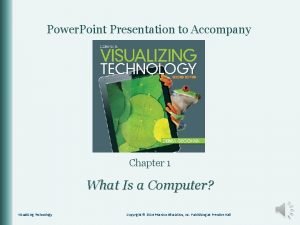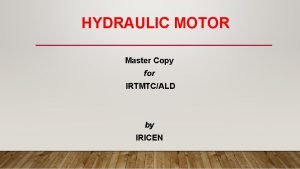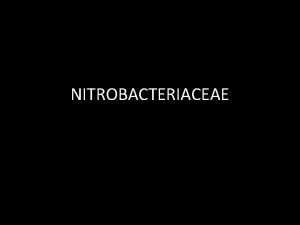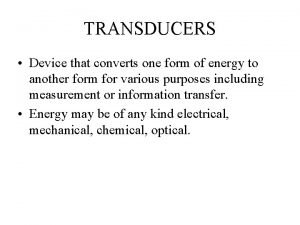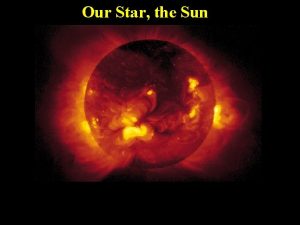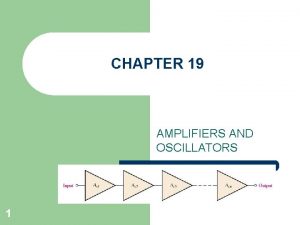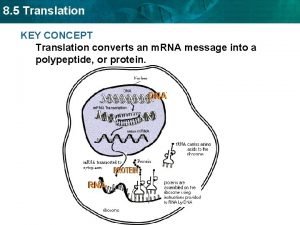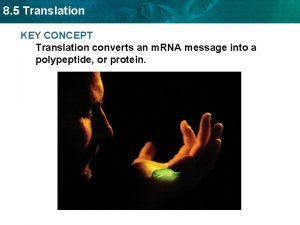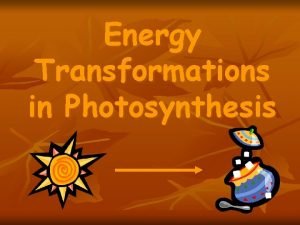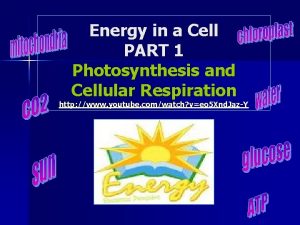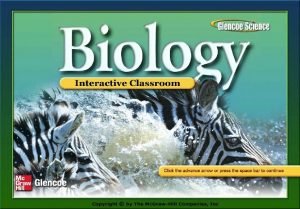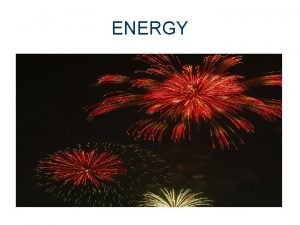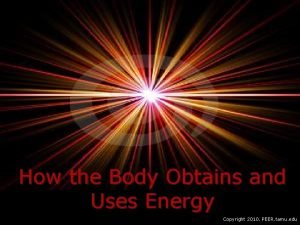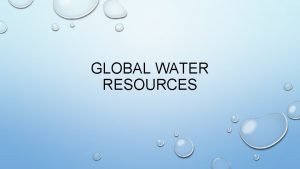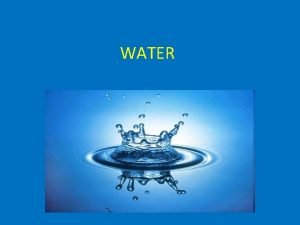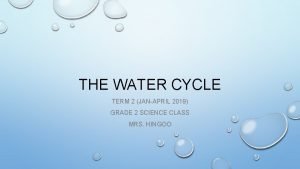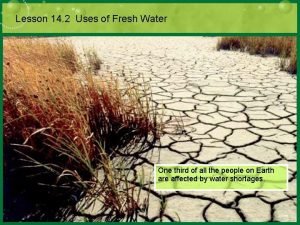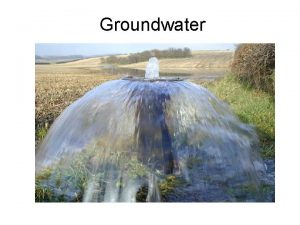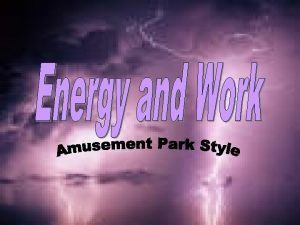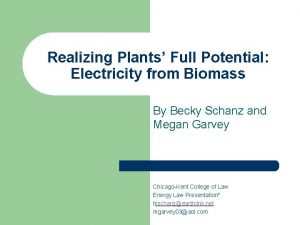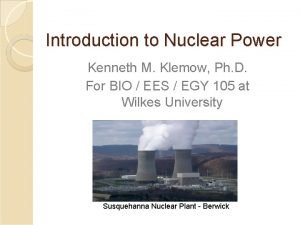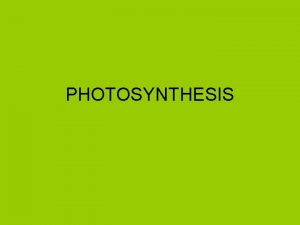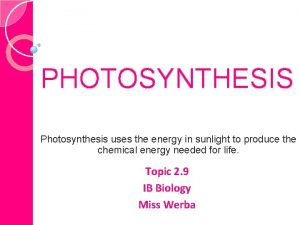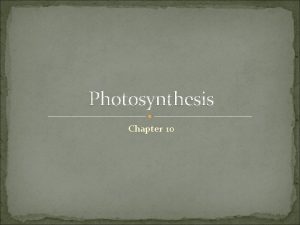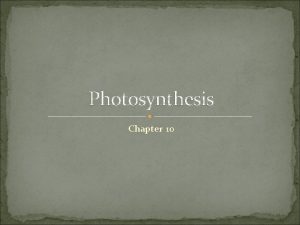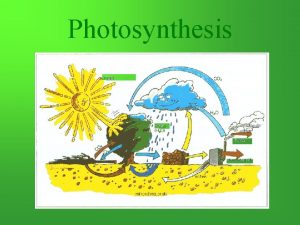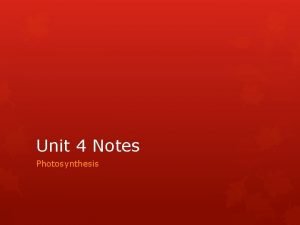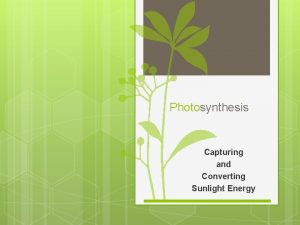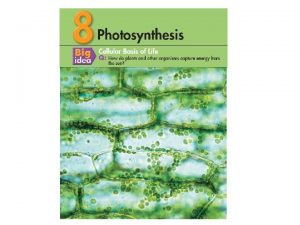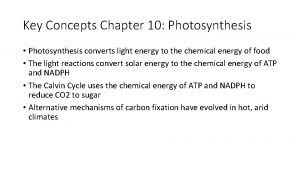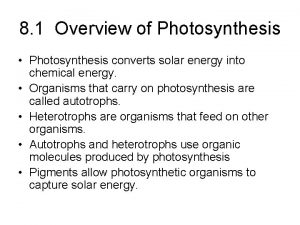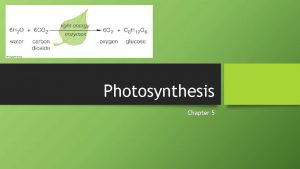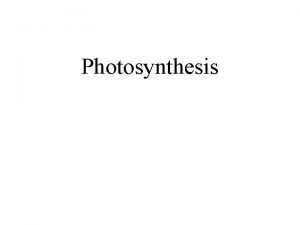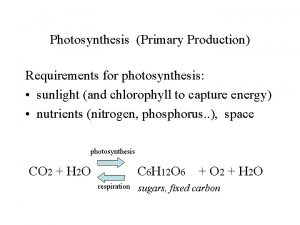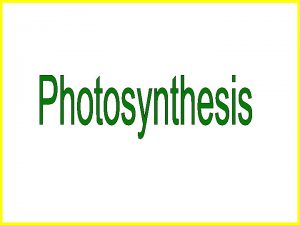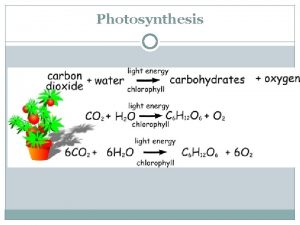PHOTOSYNTHESIS Uses energy from sunlight Converts water and




























































- Slides: 60

PHOTOSYNTHESIS Uses energy from sunlight Converts water and carbon dioxide from the environment into organic food molecules and oxygen gas


Photosynthetic organisms – many kinds, terrestrial and aquatic

Grasslands

Oceans

Freshwaters

Two Sets of Reactions 1. Light-dependent (“light”) Reactions - thylakoid membranes - chlorophyll absorbs sunlight - makes energy molecules ATP - Makes O 2 gas - reduces electron carrier NADP+

2. Light-independent reactions Calvin cycle (“dark” reactions) • Uses energy molecules from light reactions • “Fixes” carbon dioxide – Changes inorganic CO 2 into a compound plants can use • Oxidizes NADPH • Makes glucose 6 CO 2 + 6 H 2 O C 6 H 12 O 6 + O 2

Visible light drives the light reactions <> Sunlight is white light, containing all colors

Colors of light Depends on wavelength (l) -Shorter wavelength - blue-violet end of spectrum higher energy -Longer wavelength -red-orange end of spectrum lower energy

Visible light: small part of Electromagnetic spectrum travels as a wave ---- behaves as a particle (photon) Shorter wavelength Higher energy

Absorption of Light Energy Plants absorb blue and red light best

Photosynthetic pigments • Plants have multiple pigments to absorb as much sun energy as possible • Chlorophyll a is the primary pigment – starts the chain of reactions • Chlorophyll b, carotenes, xanthophylls and others are accessory pigments. • They absorb wavelengths that chlorophyll a cannot absorb use more of sunlight

Chromatography Separates a liquid mixture by solubility

Colors of light absorbed by a chloroplast Colors NOT absorbed are reflected or transmitted -- the colors we SEE Absorbed light energy is transferred to electrons in pigment -- energized electrons Chlorophyll absorbs mostly from the red and blue ends of the spectrum - reflects green.

Parts of a chloroplast Thylakoid membranes - have chlorophyll - absorb sunlight - site for 1 st set of reactions Granum – stack of thylakoid sacs Stroma – fluid surrounding thylakoids - site for 2 nd set of reactions

Parts of a Leaf

What is a Photosystem? A cluster of pigments and other molecules in thylakoid membranes • Capture light energy • Energized electrons begin reaction chains that make ATP and NADPH

What are electron carriers? Electron carriers are compounds that accept high-energy electrons from one molecule in a chain of reactions and transfer them to another molecule in a later reaction. a. Also usually accept hydrogen ions (H+) b. Transferring electrons and H+ transfers energy c. In photosynthesis, NADP accepts electrons and H+, becoming NADPH d. Helps change sunlight to chemical energy

Light reactions are a series of oxidation and reduction reactions • Oxidation – losing energy – – Lose an electron (alone or on atoms) Lose a hydrogen atom (H+ + e-) Lose a phosphate group (PO 4) Be broken apart (decomposed, hydrolyzed) • Reduction – gain energy – Gain electrons (alone or on atoms)

What is NADP? • NADP accepts electrons and H+ ions NADP + H NADPH • H comes from water in “light” reactions • Gives H to CO 2 in “dark” reactions • Electron energy helps power reactions Coenzyme – helps in a reaction but is not the catalyst

The Light Reactions 1. Photosystems absorb sunlight a. excited electrons from chlorophyll transfer to Electron Transport Chains b. Make ATP and NADPH 2. Light splits a water molecule H 2 O 2 H+ + 2 e- + O b. H+ reduce NADP + Oxygen O 2 c. Electrons -- replace electrons lost from chlorophyll

Light reactions

Electron Transport Chain Electrons pass from one acceptor molecule to the next in a series (chain) of oxidation-reduction reactions Energy from electrons pumps H+ across membrane proton gradient in thylakoid space

Chemiosmosis and ATP Synthase • • • ATP Synthase – an enzyme in thylakoid membrane Electron transport chain generates H+ gradient H+ ions diffuse through ATP synthase activate synthase enzyme Phosphorylates ADP (ADP + P) • Makes ATP ADP + P ATP

Chemiosmosis

Summary of Light reactions 1. Capture light energy, make ATP 2. Split water (H 2 O) into 2 H+ + O + 2 e 1) Electrons replace those lost from chlorophyll 2) O makes oxygen gas 3. Add H+ and e- to NADPH 1) Later they become part of glucose molecule

Light Reactions

Calvin Cycle “Dark” reactions, or Light-Independent Reactions In stroma of chloroplast • Uses ATP made in light reactions • Fixes CO 2 from air • Adds H+ ions from water • Adds electrons from ETC Makes GLUCOSE

How is sugar made? CO 2 + H PGAL (3 carbon sugar) 2 PGAL 1 glucose Carbon fixing – CO 2 gas made into an organic compound Energy needed to make glucose comes from ATP made in the light reactions

Calvin Cycle in stroma Ru. BP (5 -C) ribulose bisphosphate Carbon is “fixed” Citric Acid (6 -C) 2 PGA (3 -C) Remaining PGAL Ru. BP ATP and NADPH are oxidized 2 PGAL (G 3 P) 1 glucose



LE 7 -5 Photosynthesis uses light energy to make food molecules Chloroplast H 2 O CO 2 Light “Fixes” carbon Absorbs light energy ADP P LIGHT REACTIONS Makes energy molecules ATP, NADPH (CO 2 becomes part of organic molecule) NADP CALVIN CYCLE (in stroma) (in thylakoids) ATP El ec tro ns Light splits water -makes O 2 Uses energy molecules made in light NADPH Makes sugar O 2 Starch Sugar Lipids proteins cellulose

Factors Affecting Photosynthesis 1. Light – bright sun, more energy a. Long days (summer), more light absorbed b. Wavelength – cannot absorb green light 2. Temperature – warm, but not too hot a. Hot days – stomata close to save water 3. Water – soil must be moist a. Water comes up through xylem in veins b. Exits through open stomata c. Water low? – stomata close

C 3 plants in hot weather? C-3 – carbon fixed into 3 -carbon compound In hot, dry weather, C-3 plants: • leaf openings close to save water • No more CO 2 comes in • Photorespiration – Intermediate products used for energy by plant – No glucose made

Guard cells open/close stomata Close when CO 2 or water is low in plant - saves energy

C-4 Plants C-4 plants fix and store CO 2 in a 4 -carbon compound while stomates are open - use stored carbon when stomates close - in hot weather, can still make sugar Corn Sugar Cane crabgrass

C-4 Pathway Stores carbon as a 4 -carbon compound in special cells around veins called bundle sheath cells When stomates close, stored carbon is changed back to CO 2 for Calvin cycle


CAM Plants Succulents cacti pineapples Fix CO 2 during the night, when it is cool enough for open stomates - Do photosynthesis during the day, using the stored carbon

Parasitic plants Supplement nutrition by taking from other organisms Dodder Plant Pure parasite – cannot photosynthesize - Special roots tap into veins of host plant

Mistletoe – supplements photosynthesis taps into host cell veins – drains sap

Carnivorous Plants Eat insects to get nitrogen Live where decomposition is slow Pitcher plant

Pitcher plant Sweet nectar at bottom of tube - Insects stuck in nectar, digested

Sundew – eats insects Sugary “dew” attracts insects Insects get stuck -Leaves enclose and digest -Absorb nutrients from insect

Venus Fly Trap Hinged leaves with “trigger” hairs Insect walking on leaves touches hairs - Leaves close, insect digested

Indian Pipe Cannot photosynthesize

Carotenes in nature Where can we see carotenes, xanthophylls, and other pigments besides in autumn leaves?

Photosynthesis reduces atmospheric CO 2 • • • Excess greenhouse gases: - from human activity -burning fossil fuels - deforestation - increases global warming - photosynthesis removes CO 2 and helps moderate warming

Greenhouse - Traps heat indoors

TALKING ABOUT SCIENCE 7. 14 Mario Molina talks about earth’s protective ozone layer • Nobel Prize winner Mario Molina has studied how pollutants are affecting Earth's ozone layer • Solar radiation converts O 2 high in the atmosphere to ozone (O 3) • The ozone layer shields organisms on Earth's surface from damaging UV radiation • CFCs have caused dangerous thinning of the ozone layer • International restrictions on CFC use are allowing a slow recovery

LE 7 -14 b The ozone layer Southern tip of South America Antarctica

Pond Mud and its Bacteria (Winogradsky Column) Anaerobic Phototrophs - purple bacteria - green sulfur bacteria

TRANSPORT IN A LEAF Water enters a leaf through the veins; xylem carries water up from the soil. Water then diffuses from the veins into the mesophyll cells. -Carbon dioxide diffuses into the leaf through small openings on the surface called stomates -Phloem carries the newly synthesized glucose to other parts of the plant where it can be used for energy or stored.

The Light Reactions of Photosynthesis – one (of two) electron transport chains Photosystem – cluster of chlorophyll, other pigments, proteins and other molecules that all work together to harvest light energy and package it in ATP and NADPH Chlorophyll absorbs sunlight -Energized electrons in chlorophyll go to E. T. C -ETC makes ATP (ADP + P) - Water is split; electrons from water replace the electrons lost from chlorophyll -Another chlorophyll also absorbs sunlight -This pathway makes NADPH (NADP + H)


ATP synthesis As in cell respiration, electron transport chain powers production of ATP by chemiosmosis through enzyme ATP synthase

The Dark (Light-Independent) Reactions of Photosynthesis Calvin Cycle -Uses energy molecules made in light reactions -ATP, NADPH -a 5 -carbon compound in the stroma is used in the reactions and then recycled -CO 2 combines with hydrogen (from NADPH) to make 3 -carbon PGAL -2 PGAL combine to make one glucose

Overview of Photosynthesis
 Which object converts sunlight into sugars?
Which object converts sunlight into sugars? A hairdryer converts ____ energy into ____ energy.
A hairdryer converts ____ energy into ____ energy. ________ converts light energy into chemical energy. *
________ converts light energy into chemical energy. * Water and water and water water
Water and water and water water Learning outcomes generator
Learning outcomes generator A loop of relatively cool incandescent gas
A loop of relatively cool incandescent gas A pole vaulter first converts kinetic energy into
A pole vaulter first converts kinetic energy into Photosynthesis transforms light energy into chemical energy
Photosynthesis transforms light energy into chemical energy Raindrops sunlight and refraction lyrics
Raindrops sunlight and refraction lyrics Energy energy transfer and general energy analysis
Energy energy transfer and general energy analysis Energy energy transfer and general energy analysis
Energy energy transfer and general energy analysis How do plants get glucose
How do plants get glucose Earth's revolution
Earth's revolution What is gravity
What is gravity Hours of sunlight map
Hours of sunlight map Seed maturation
Seed maturation Siklus hidup produk sunlight
Siklus hidup produk sunlight Biotic factors examples
Biotic factors examples Cd to lux
Cd to lux Radiation heat transfer examples
Radiation heat transfer examples Value added products of cauliflower
Value added products of cauliflower Introduction to beauty
Introduction to beauty Big idea 17 study guide interdependence
Big idea 17 study guide interdependence Pelagic zone
Pelagic zone How much sunlight does the marine biome get
How much sunlight does the marine biome get Biotic and abiotic factors definition
Biotic and abiotic factors definition Oscillator principle
Oscillator principle Pn junction diode, converts
Pn junction diode, converts Lactobacillus bulgaricus converts lactose to *
Lactobacillus bulgaricus converts lactose to * Primary and secondary transducer
Primary and secondary transducer Pn junction diode, converts
Pn junction diode, converts Line regulation
Line regulation Pn junction diode, converts
Pn junction diode, converts Arno converter converts
Arno converter converts Decoder biner to octal terdapat pada ic
Decoder biner to octal terdapat pada ic A computer is a programmable machine that converts raw
A computer is a programmable machine that converts raw Hydraulic motor working principle
Hydraulic motor working principle Nitrobacter
Nitrobacter Wire strain gauge
Wire strain gauge Sun surface temperature
Sun surface temperature An oscillator converts …………….. *
An oscillator converts …………….. * Translation converts
Translation converts Translation converts
Translation converts Radiant energy photosynthesis
Radiant energy photosynthesis Photosynthesis energy transformation
Photosynthesis energy transformation Cellular energy section 2 photosynthesis
Cellular energy section 2 photosynthesis All types of energy
All types of energy The human body obtains energy through
The human body obtains energy through Apa yang dimaksud dengan dock water allowance
Apa yang dimaksud dengan dock water allowance What industry uses the most water
What industry uses the most water Uses of water
Uses of water Hydrosphere facts
Hydrosphere facts Importance of water cycle
Importance of water cycle Uses of surface water
Uses of surface water Uses of surface water
Uses of surface water Types of magnetic energy
Types of magnetic energy Sample of mechanical energy
Sample of mechanical energy What is mechanical energy
What is mechanical energy Uses of biomass energy
Uses of biomass energy Electrical energy uses
Electrical energy uses Uses of nuclear energy
Uses of nuclear energy
